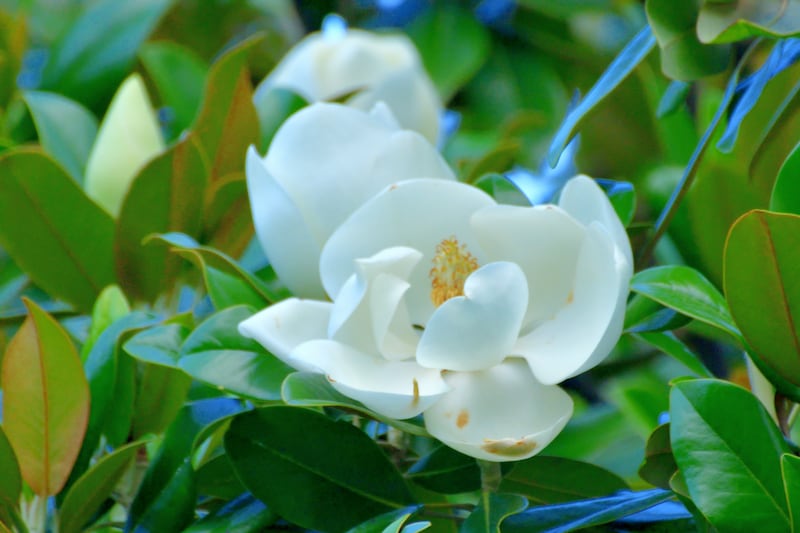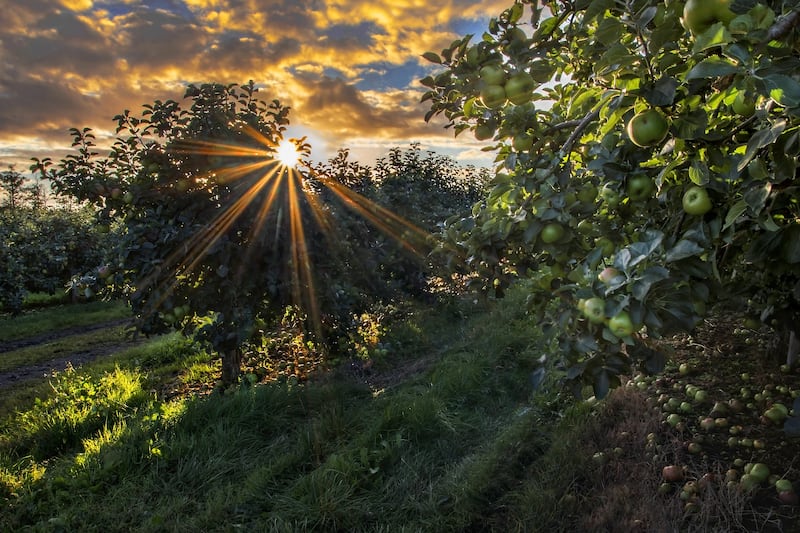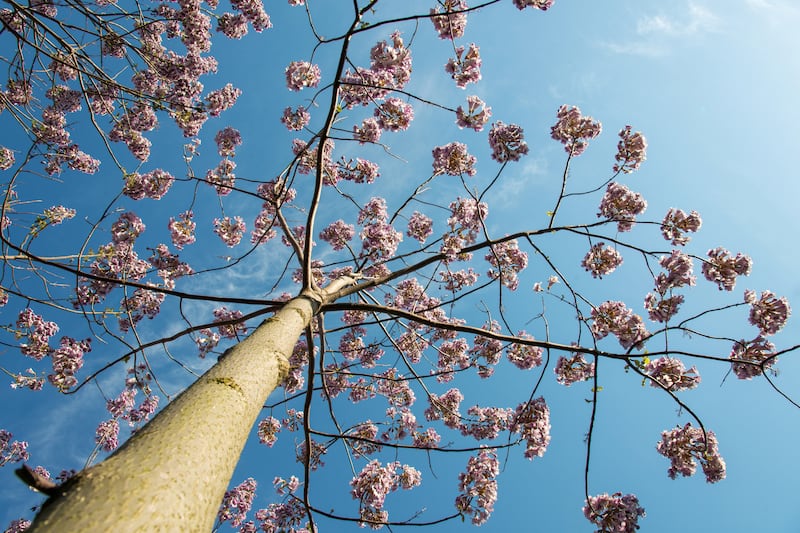It’s strange how rarely we associate the scent of flowers with trees, something that struck me this month as I stepped out of a hot car into the cool shade of a sleepy Irish village square only to be enveloped in the sweet, lemon-honey tang of a line of mature limes (Tilia x europea) in full summer bloom. Commonly known as the linden tree, its loose clusters of pale yellow-green flowers could never be described as conspicuous. In fact, many people probably wouldn’t even recognise them as flowers. But oh, that wondrous smell, a distinctive perfume that draws pollinating insects to them like the sweetest lure. No wonder the distinguished British nature writer Richard Mabey once wrote that you can both hear and smell lime trees in summer before you see them.
It’s not just populations of bees and other pollinating insects that these wonderfully stately trees support. Many species of moths use their leaves as food for their larvae. Aphids also feed on the trees’ sugar-rich leaves, producing their distinctive “honeydew”, which in turn provides food for birds, bees, hoverflies and ladybirds. Older trees are also often home to wood-boring beetles and nesting birds.
Of course, few Irish gardens have the space to accommodate a common lime tree, which can eventually reach a majestic height and spread of 40m x 15m. But smaller species suitable for large, sheltered gardens with an alkaline soil include the silver lime (Tilia tomentosa) and the small leaved lime, Tilia cordata ‘Greenspire’, whose upright habit makes it a good choice for growing along a formal avenue or driveway.

Lime trees aside, there are many other garden-worthy trees whose scented, wildlife-friendly flowers make them worthy of consideration. Magnolias, for example, have the very same ability to ambush us with the intense scent of their large flowers, an unexpected boon that takes many by surprise. Examples include the deciduous, spring-flowering, Magnolia ‘Heaven Scent’, a great small tree for any sheltered town garden with a cool, deep, rich acidic soil, whose giant, rose-pink, cup-shaped, vanilla-lemon scented blooms appear on bare stems in spring. Both the spring-flowering Magnolia x loebneri and the star magnolia, Magnolia stellata, are also known for their heady perfume and are suitable for smaller gardens.
READ MORE
The large, pale blooms of the lily tree (Magnolia denudata), also spring flowering but suitable only for larger gardens, are similarly deeply scented. So is the late summer-flowering bull bay or Southern magnolia, Magnolia grandiflora, an evergreen species tolerant of alkaline soils with large, pale, goblet-shaped, intensely perfumed blooms, that can also be grown as a wall shrub. Suitable for container growing as long as they are kept regularly watered, well-fed and repotted with fresh compost every three to four years, the evergreen, autumn-blooming Camellia sasanqua is yet another member of this outstanding genus of woody plants known for its scent.

Of course, one of the wonderful things about any species of tree with fragrant blossoms is the sheer profusion of those flowers and the scale of the olfactory hit that they provide. If you’ve ever visited Spain in spring, when its orange groves are in full blossom, you’ll know that the scent floats on the warm air for miles, filling buildings and streets with its sweet, heady notes of honey and citrus. We don’t have orange groves in Ireland but we do have apple trees, whose late spring blossom fills the air with delicate, floral perfume. Similarly, stand beneath the branches of a false acacia (Robinia pseudoacacia) in late spring-early summer and you’ll immediately smell the orange-blossom scent of its drooping clusters of pale, pea-like flowers. Or walk beneath the branches of a serviceberry tree (Amelanchier) in spring bloom and you’ll be as seduced by its perfume as you are by the display of its starry, pale flowers.
That arboreal profusion of flowers is, as mentioned earlier, also wonderful for garden wildlife, the size and scale of the display easily outgunning the power of any flowering perennial. For example, not only does the pale-pink blossom of the ornamental cherry known as Prunus ‘Amanogowa’ smell of crushed almonds with a hint of freesia, but the innumerable nectar and pollen-rich flowers that this hardy, adaptable small deciduous tree produces are also irresistible to many kinds of pollinating insects.
The same goes for the scented, starry white flowers of the late summer-autumn flowering evergreen tree known as ribbonwood (Hoheria sextylosa), which blooms at a time of year when many other woody species are not in flower. Hoheria needs a sheltered spot in full sun or light shade and a neutral to alkaline, deep, fertile soil to flourish. It eventually reaches a height and spread of 6m-8m, making it a good choice for a walled or large courtyard garden.

Another somewhat tender species of flowering tree that similarly makes a great specimen plant for an enclosed, warm sheltered space is the foxglove tree (Paulownia tomentosa). This deciduous, exotic tree’s giant leaves are offset by large spikes of trumpet-shaped purple foxglove-like flowers in April (hence its common name), which have a delicate whiff of vanilla. Many gardeners like to keep this fast-growing species in shape by annually coppicing it as, left to its own devices, it can take eventually form a spreading canopy of up to 12m tall.
It is not commonly available in most Irish garden centres. Finlay Colley’s little treasure trove of a nursery, Rare Plants Ireland (rareplantsireland.ie), on the outskirts of Clondalkin, Co Dublin, stocks it along with a great selection of other unusual, less than fully hardy species of flowering trees that will survive in warm, sheltered Irish gardens. These include the pineapple guava (Acca sellowiana), whose aromatic, crimson flowers are also edible; the pineapple-scented spring-flowering Acradenia franklinae; and the silk tree (Albizia julibrissin), whose perfumed pompon flowers have a rich fruity smell that’s been described as reminiscent of a mix of watermelon, pomegranate and lychee.
This week in the garden
With little sign of any period of sustained high temperatures in the coming weeks, crops growing outdoors in kitchen gardens and allotments are proving slow to bulk up, flower and fruit. Help them by covering them with a layer or two of horticultural fleece or climate net to protect against low temperatures (see quickcrop.ie and fruithillfarm.com).
If you’re looking for a nature-friendly way to cut back sections of a lawn that has been left to grow tall and flower, then consider investing in an Austrian scythe. Unlike a conventional strimmers, this supremely useful tool will easily handle long, lush, wet growth.
Dates for your diary
July 20th, 5.30pm-11pm, The Grinding House, June Blake’s Garden, Tinode, Blessington, Co Wicklow: Journeys & Reflections, a guided tour of this magical Wicklow garden by its owner and creator, June Blake, followed by an evening of storytelling hosted by the storytelling group Craicly, and accompanied by Flowers, an exhibition of work by the artist Ciara Gormley, booking essential, tickets €65 include supper and refreshments. craiclystories.com, juneblake.ie, eventbrite.ie

















